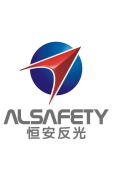Micro prism type reflective film and its application prospect
Reflective film is a new functional composite material developed in the last 50 years. Micro prismatic reflective film is developed in the late 1980s, due to its high brightness, good durability, and overcome the previous prism type reflective materials effective incident angle is small, observation angle small, the asymmetry of the reflected beam shortcomings, so in need of high brightness of highway transport plane is used more and more widely.
1, reflecting the principle and composition of the structure
1.1 principles
The reflection principle of the micro prism type reflective film is based on the light in the three-dimensional space, from a certain angle of incidence, in the mutual perpendicular to the 3 plane 3 reflection occurs, and then reflected back along the original direction of incidence, see figure 1.
According to the manufacturing process, there are two kinds of reflection in the prism surface: one is the air resin interface, the other is the reflection of the aluminum resin interface.
1.2 according to the structure of different classification
According to the different types of reflection and micro prismatic reflective membrane structure can be divided into two (see Figure 2, figure 3): coating type reflective film (ASTM4956 said to type V sheeting) and uncoated type reflective film (ASTM4956 said for the type IV sheeting). Due to the coating type reflective film color gray, the market outlook is bleak.
The structure of these two kinds of reflective films is different:
(1) no coating type reflective film pyramid is behind the air, and thus the reflection is mainly total internal reflection. This requires the pyramid must be a stable air layer, so in the reflective film without coating type have a layer of sealing layer (Sealingfilm) (see Figure 2), in order to prevent moisture, dust and other miscellaneous matter in the air layer, resulting in decreased in an inverse reflection coefficient.
(2) a type of reflective film after coating pyramid is coated with a layer of metal, usually aluminum. Reflection is mainly carried out on the resin aluminum interface. There is no sealing layer of coating type reflecting film.
(3) due to the non coated reflective film needs to be closed, so there is a support wall, from the front view, is a diamond or a hexagonal lattice. While the coating type reflective film is not.
2, the performance of micro prism type reflective film
2.1 optical properties
In the light of the reflection intensity and the wide angle, the micro prism type reflective film is greatly improved than the lens type reflective film. Fig. 3 is a comparison of the initial value of the initial value of the 4 types of products (0.2 degree observation angle).
The reflection light cone of the previous micro prism type reflecting film is asymmetrical, the effective incident angle is small, but the design of the reflecting unit and the array is basically solved.
2.2 weather resistance
Although micro prismatic reflective film after the service life has been reached, inverse reflection coefficient decreased by 50%, but the reverse reflection coefficient can still keep in 400cd, lx-1 m-2, far higher than the other two types of reflective film, as shown in Figure 5 (0.2 degree observation angle, 4 degree angle of incidence angle).
3, micro prism type reflective film manufacturing technology key
3.1 key technologies
Although the basic principle of micro prism type reflective film is simple, the manufacturing technology is involved in many fields, such as materials science, optics, precision machinery manufacturing, etc.. It is concluded that there are 4 key technologies in the fabrication of micro prism type reflective film.
3.1.1 cell structure and its array design
The traditional prism type reflective material mainly has the following disadvantages:
(1) the effective incidence angle is small, when the incident angle is greater than 20, the reflection is almost lost because of the total internal reflection.
(2) the observation angle is small, people can see reverse light in the distance, but not near.
(3) due to the three sides of the reflection unit, the reverse reflection light cone has different requirements of the asymmetric shape, and the results are different from the different scanning angles.
The methods to solve these problems mainly rely on counter reflection unit structure and array design, such as transform a plane of the angle between the there are some distribution, or the cell array according to the certain rule configuration. But due to the complexity of the structure and the array design, to the motherboard, complex type, forming mold, have caused great difficulties, so not easy to implement.
Making 3.1.2 motherboard and complex type
Due to the micro prismatic reflective unit at the height of the 0.003~0.015in (0.078 2~0.381mm), and irregular shape, arranged in the plane also has certain rules, and the forming surface smooth degree requirements are very high, and motherboard need precision machining. The board itself is not directly involved in forming, processing prices are expensive, the area is limited, and the mold is not high. Can produce complex mould using copy motherboard, and the spliced into any size, in order to facilitate industrial production.
Determination of 3.1.3 substrate
As a micro prismatic reflective film, the main material is engineering plastics, according to the different requirements of the use of performance, choose different plastic film. The index and solves the problems considered are: weathering resistance, plastic base material preheating properties and rheological properties. TID currently under different product series, mainly used PVC, PC, PMMA, PET several materials.
3.1.4 embossing technique
Due to the high requirements of the micro prismatic reflective film on optical properties, so its embossed precision is quite high, in the embossing process, does not allow bad flow, bubble, scratches etc. defects, the process conditions, such as temperature, pressure and other requirements are very harsh.
4 application prospects
Due to the micro prismatic reflective film of high reflective intensity and good wide-angle performance, with the continuous improvement of the motor speed, the continuous growth of the high grade highway, road conditions of continuous complex, the application of micro prismatic reflective film market will become more and more broad. But other problems caused by the high strength, such as glare, and practical application of pattern and background contrast determines the micro prismatic reflective film also can not completely replace the glass microbead reflective film.





